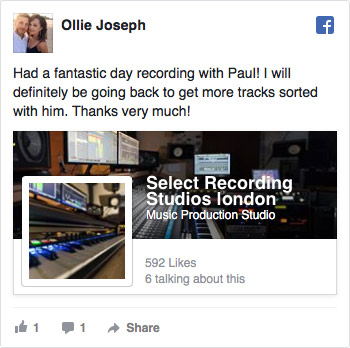FAQs: Recording For Solo Artists
When a singer or artist wishes to sing over an instrumental or backing track we follow the process below:
Usually the artist will bring their own instrumental or backing track to the studio for us to work with. After warming up, the singer or artist will sing the song through in its entirety. Usually four or five complete "takes" are recorded. Each "take" is listened through and the best versions of the vocals are chosen and pieced together to make one perfect vocal track. The performance is checked to see if any sections need tuning (pitch correction).
Vocal effects are then added: EQ, compression, reverb, echo, etc. Certain sections of the vocal track may also be double-tracked to add depth. Sections may also have extra effects applied where suitable or desired. Finally, the song is mixed and mastered onto CD or to MP3 format.
When a group or band wishes to record a track we generally follow the process below:
Usually the most important thing when listening to a song that has just been recorded is to make sure that the drums sound correct and that the drummer is happy with that "take". We check that there are no trimming problems and, if there are any, we correct them. Often guitarists and bass players will wish to re-record their parts and add overdubs. The best "takes" are then chosen and edited. Effects such as EQ, compression, and others where appropriate to the feel of the song, are also then added. Finally, the singer's vocals are recorded alongside this instrumental track.
After warming up, the singer usually sings the song through four or five times. We go through each "take" and pick the best versions of the vocals to make one perfect vocal recording. The vocal track is then checked to see if any sections need tuning (pitch correction). Vocal effects are then added: EQ, compression, reverb, echo, etc. Certain sections may be double-tracked to add depth and particular sections may have extra effects applied. Finally, the song is mixed and mastered onto CD or to MP3 format.
The studio engineer's role is to work with the artist and producer to achieve the best possible recording. Initially, this starts with setting up the studio space by choosing and positioning microphones and other equipment which are needed to record a particular artist or group. The studio engineer has a deep knowledge of the studio and knows the capabilities of all of the elements of studio equipment, including microphones and outboard FX. During the recording, the engineer is also on-hand to assist with specific sound or effect requirements which an artist might require and works alongside the producer to achieve a successful recording session.
It's important to prepare well for a studio session in order to make the best use of your time in the studio and to get the best out of your session. Ideally, you should have a strong idea of the style of your song and how it should be recorded before you arrive. It is helpful if you can bring with you any reference tracks that you like or tracks which have a similar style to what you are aiming for.
Once you are in the studio the time will pass quickly, so it is important to have a very clear idea of your goals and to be realistic about what can be achieved during the session. If you are working with other musicians it is important that they are aware of the recording goals and also what is required of them, especially in terms of their familiarity with the song arrangements, the instruments required and your recording schedule.
Warming up is important to ensure that your performances are of a high standard from the very beginning. Arrive in good time for your session so you stand the best chance of starting the session off in a relaxed way and achieve your optimum level of performance quickly.
During an extended recording session, ensure that you maintain concentration levels and be sure to eat and drink regularly to keep energy levels up. Avoid foods and drinks with high sugar content as these tend to lead to energy highs and lows - water is best.
















